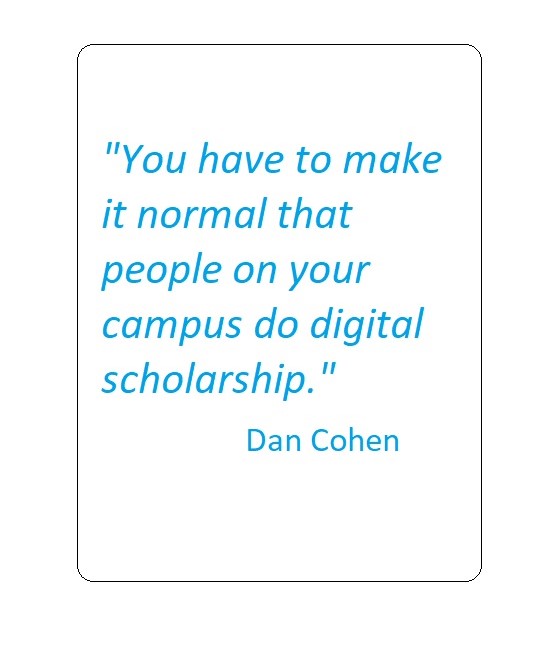As the CUA Libraries continues expanding the digital scholarship opportunities for the CUA community, it may serve us to see what others have done. No better example can be found of the trials and tribulations of creating and supporting digital scholarship than the founding of the Roy Rosenzweig Center for History and New Media at George Mason University.
Dr. Dan Cohen, the former director of the RRCHNM, gave the plenary address to the CNI-ARL Digital Scholarship Planning meeting at Brown University, November 8-10, 2017. Dan is the Vice Provost for Information Collaboration, Dean of Libraries, and Professor of History at Northeastern University in Boston, MA. He talked about the issue of institutionalizing digital scholarship. Establishing a digital scholarship center is challenging as he regaled the audience with tales from the establishment of the RRCHNM that was established at George Mason University Roy Rosenzweig in 1994 (cue the raccoons with fleas at 15:25 in the video below).
Cohen outlined three major themes that digital scholars and librarians will need to develop to be successful in insitutionalizing digital scholarship, what he calls “the three critical elements of institutionalization:
Routinizing

Working on individual projects is fine as librarians, and consulting with faculty and students in getting set up basic digital humanities projects goes with the territory. However, every librarian will tell you that such endeavors are time consuming and in the end, individually unsustainable. What is needed is a routinization of workflows, policies, and procedures with dedicated individuals expanding their knowledge of the larger process.
Normalizing
As Dr. Cohen mentions, new activities cannot remain on the fringe. “You have to make it normal that people on your campus do digital scholarship,” says Cohen. They need to be incorporated into your instiution’s workflow; in short, to be normalized into the everyday tasks of your organization. Outreach and developing allies who understand what you are doing and want to be part of digital scholarship. The long term goal is to have members of your institution think of the library when they think of digital scholarship practices. In the end, this becomes a marketing exercise.
Depersonalization
Great ideas come from individuals (for the most part). These founders create new products and services. However, founders move on (or die) and many DS labs, centers, and organizations flounder and fall once the founder is gone. The digital scholarship paradigm within the academic instiution must not only survive but flourish when staff turnover takes place. Every person involved in DS should make it a priority of how their projects and workflow will succeed them when they leave.
Lessons learned: Be careful not to spread yourself too thin. The nature of your institution will determine what you are able (and should offer) in the way of promoting the mission of the university through consultations, creating exhibits, experiential learning, information literacy classes, coding services, etc. Focusing on matching with faculty scholarly interests will be vital for success.
The full presentation is on YouTube and a summary of the talk is available on his blog.

One thought on “Institutionalizing Digital Scholarship at CUA”